GLASGOW
UNIVERSITY LIBRARY
SPECIAL COLLECTIONS DEPARTMENT
Book of the Month
September 2008
Photographs of
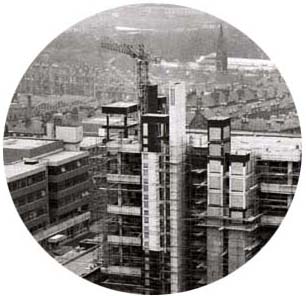
University of Glasgow Library under
construction
Glasgow: 1965-1971
Sp Coll Photo A49
|
This month the current University of Glasgow Library building celebrates
its fortieth birthday. In acknowledgement of this auspicious occasion,
our Special Collections 'book of the month' features a series of
photographs that document the construction of the building in the 1960s.
There will also be a dedicated exhibition in the
Library's new display area on level 3 from the beginning of
October. |
|
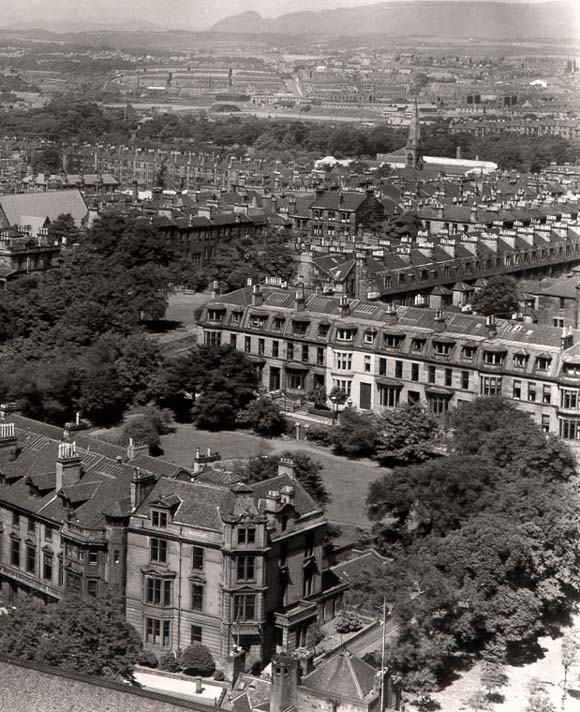
Photo A49/19: detail showing site of new library, 1965
|
Discussion surrounding the need for a new building for the
University's Library began at a Library Committee meeting on 6
December, 1946. Years of negotiation and debate followed. It was obvious
that the original 19th century accommodation in the Gilbert Scott
building was no longer adequate;
having changed little since the University's move to Gilmorehill in
1870, it was overcrowded and outdated, with insufficient space for
both books and readers. This situation would become even more critical
with the publication of the Robbins report (1961-63),
recommending a huge and rapid expansion in higher education.
The building took several years to plan and was conceived by Robert
Ogilvie MacKenna, who was University Librarian for 26 years from 1951
until 1978. He wanted flexible uninterrupted
floor space with open access bookstacks and plenty of reading space.
His brief included "simplicity of general plan, adaptability to
changing needs and patterns of teaching and service, and capability of
further extension after completion of the full original design."
The designer was William Whitfield. He drew up initial sketches and
models for the projected building in 1961. He wanted it to be a
landmark to complement the tower of the main University building,
designed by Sir George Gilbert Scott in 1865.
The 1960s structure was only intended to be Phase I of an ambitious
development project. Phase II was to extend the work to the south to
create a new museum and art gallery that would be connected to the
Library. Phase III would then enlarge the Library to the north,
expanding the space in an extension that would be a mirror image of
the first building.
|
|
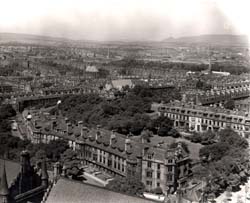
Photo A49/1: site of new library, 1951
(click on this image to see a larger version)
|
Our sequence of photographs begins with views of Bute Gardens and Hillhead
Street, before demolition began to clear the site for construction. The area
earmarked for the new building was at the crest of Hillhead Street, the
highest point of the university site and a central position on campus. It
was a confined site, and the planned building was therefore forced to be
high rise in nature. Built at a time when the sacrifice of Victorian
architecture was not a matter for great concern, gardens and several houses had to be demolished to make way for the new edifice. |
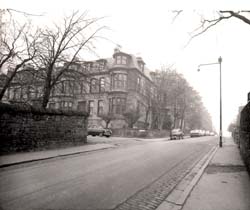
Photo A49/13: Hillhead Street, 1965
(click on this image to see a larger version) |
|
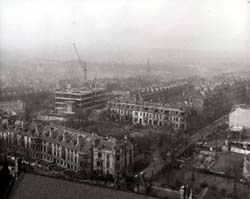
Photo A49/19: site of new library, 1965
(click on this image to see a larger version) |
The photograph to the left shows the extent of University expansion
occurring simultaneously: it is February 1965, and although work on the
Library has yet to be started, the Adam Smith building (completed in 1967
and now behind the Library building) and refectory (which opened in 1966 and
is now in front of the Library and currently being redeveloped) are under
construction.
The University as a whole desperately needed new buildings at this time.
After the war, the University Grants Committee (UGC) was permitted to fund
capital projects for the first time; extensions to various buildings were approved and new
buildings planned. A new library building had been originally incorporated
into a radical development drawn up by Sir Frank
Mears in 1951. His proposals for Hillhead also included an art gallery, student
recreational building, additional teaching facilities and student residences
- all to be arranged around open quadrangles connected by covered walkways.
Mears' grand design was never realized. |
| The contractor began work on Phase I of Whitfield's version of the new
library on February 15th, 1965. The architect in charge was Philip Sayer.
Work would take some three and a half years. The
demolition of the buildings of Bute Gardens was the first stage of the
process. This included the loss of an overflow store for library books at 7
Bute Gardens. Since there was no room for any more stock in the old library,
some books had to be temporarily transferred to the Mitchell Library for
storage. Rapid progress was made. At this early stage, it was hoped that
the new building would be ready for occupation before the end of 1967. The
skeleton of the Adam Smith building can be seen in the background of this
photograph, taken on 26th April 1965. |
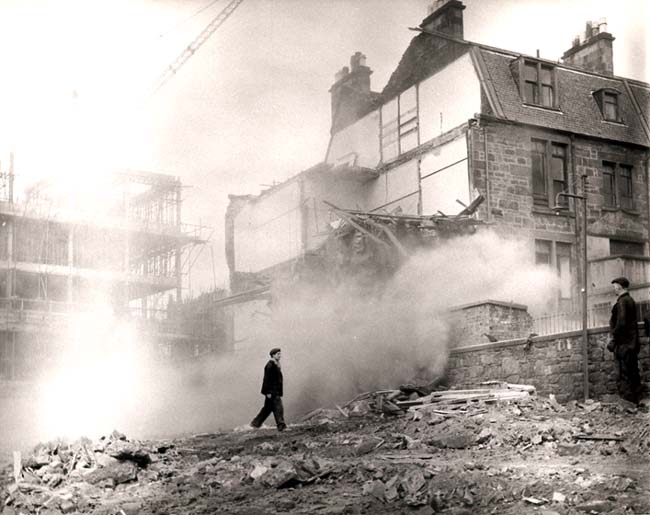
Photo A49/22: demolition of Bute Gardens, 26 April 1965
|
|
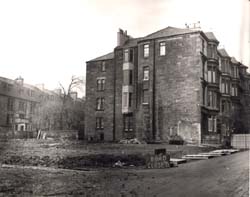
Photo A49/25: Hillhead Street, 26 April 1965
|
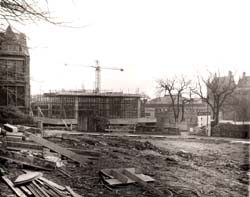
Photo A49/27: site for new Library, 26 April 1965 |
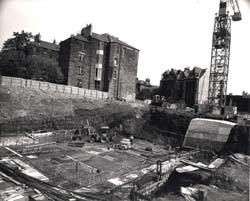
Photo A49/30: foundations, 17 May 1965 |
|
click on these images to see larger versions of the photographs
|
|
The foundations and external walls were to be the most costly elements of
the project. The average depth of excavation was 23 feet, 6 inches.
Meanwhile, the presence of underground mining works meant that a reinforced
concrete raft (measuring 4 feet and 6 inches in depth) had to be built as a base for
the building.
|
|
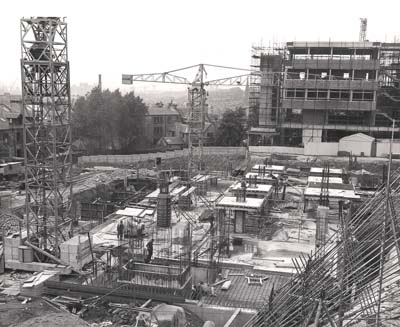
Photo A49/41: Library under construction, 12 July 1965 |
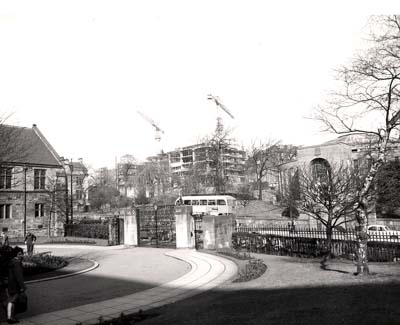
Photo A49/43: Library under construction, 16 March 1966 |
Although construction proceeded at an impressive rate,
there were inevitably some delays. There were, for instance, unexpected difficulties
with the foundations of closely
adjoining buildings in Hillhead Street, resulting in the need for costly piling.
There was also
uncertainty over the planning permission needed to close Hillhead Street
once the building was completed; this delayed work beginning on the entrance porch and approach staircase. The hope for an
early start on the projected connecting art gallery foundered. By 1966
it was clear that the move to the new building would not now take place
until the long vacation of 1968 at the earliest.
|
|
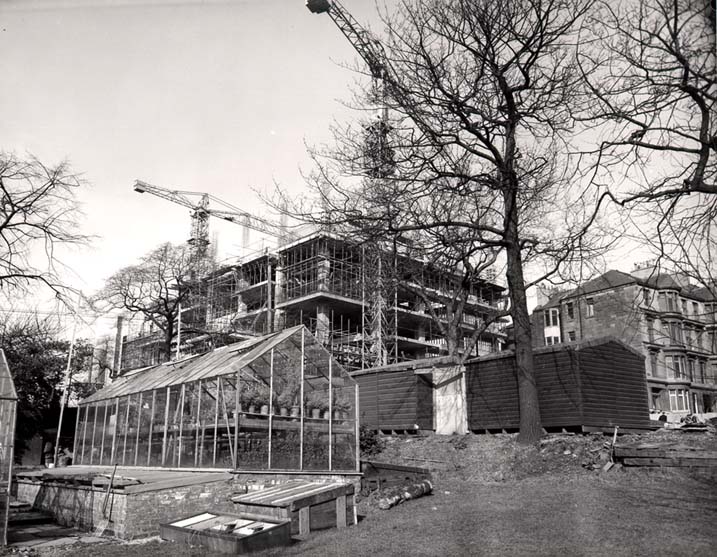
Photo A49/47: glasshouses on Reading Room lawn, 16 March
1966 |
The Library Committee report for the 1965-66 session remarks that this
was a "difficult year that left behind it mixed impressions, amongst
which feelings of frustration, uncertainty and strain were probably
predominant. The new building, now beginning to cast an impressive physical
shadow, also laid a heavy metaphorical shadow over all activity".
Staff in the old library accommodation struggled to provide a service in
a congested building that could no longer cope with increasing numbers of
staff and students as the University outgrew itself in offering new courses.
Meanwhile, MacKenna's time and energy was almost wholly taken up by the questions
and problems of planning the new internal arrangement and staffing structure
of his new library.
|
|
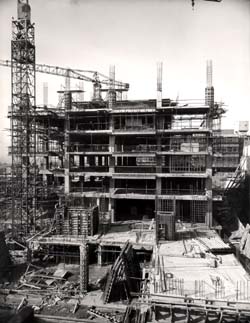
Photo A49/51: Library under construction, view from East,
16 March 1966 |
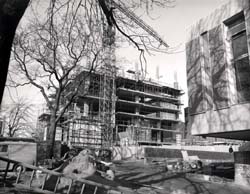
Photo A49/53: refectory with Library under construction in
background, 16 March 1966
(click on these images to see larger versions of the
photographs)
|
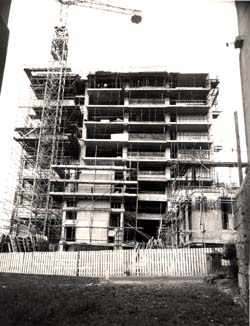
Photo A49/58: Library under construction, view from East,
1 August 1966 |
|
|
|
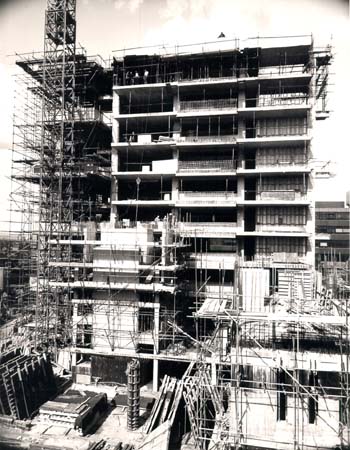
Photo A49/64: Library under construction, 1 August 1966.
|
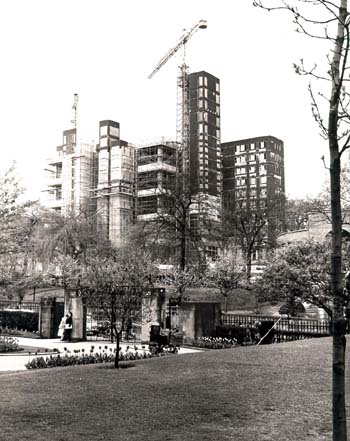
Photo A49/70: Library under construction, 5 May 1967
|
| As the building grew, its imposing structure became
obvious. It would soon dominate the skyline of Glasgow's West End.
|
| The building was designed by Whitfield to have a
deliberately vertical emphasis. The original building consisted of 11 floors
(with an additional mezzanine floor in the closed stack sub-basement). The
main core working space was surrounded by six peripheral service towers that
housed "noisy" elements such as staff offices, study rooms, toilets, lift
shafts and staircases. The towers were structurally isolated at every level
to allow for differential movement. An earlier plan for the building would have produced a somewhat "dumpy" building mass "which
would have been unacceptable as a contribution to the total architectural
effect and to the distant skyline". Whitfield's incorporation of independent
towers was praised by the Architectural Review for changing the outline of
the building "from that of a lumpish cube to that of a cluster of vertical
elements" thereby making a successful contribution to the skyline. Whitfield
himself described it as "a kind of disruptive camouflage" and claimed to
have been influenced by the geometrical form of Northumbrian border castles. |
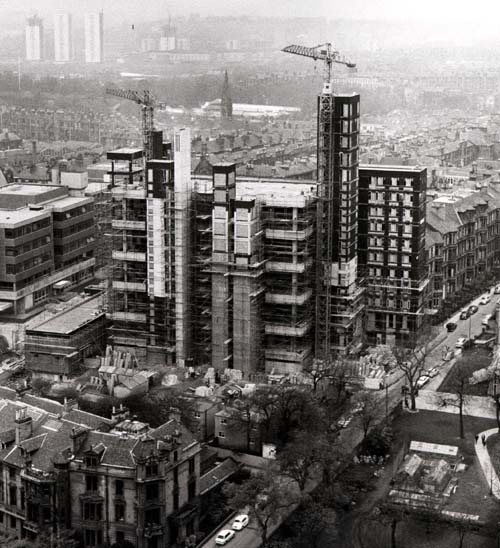
Photo A49/71: Library under construction, 5 May 1967 |
|
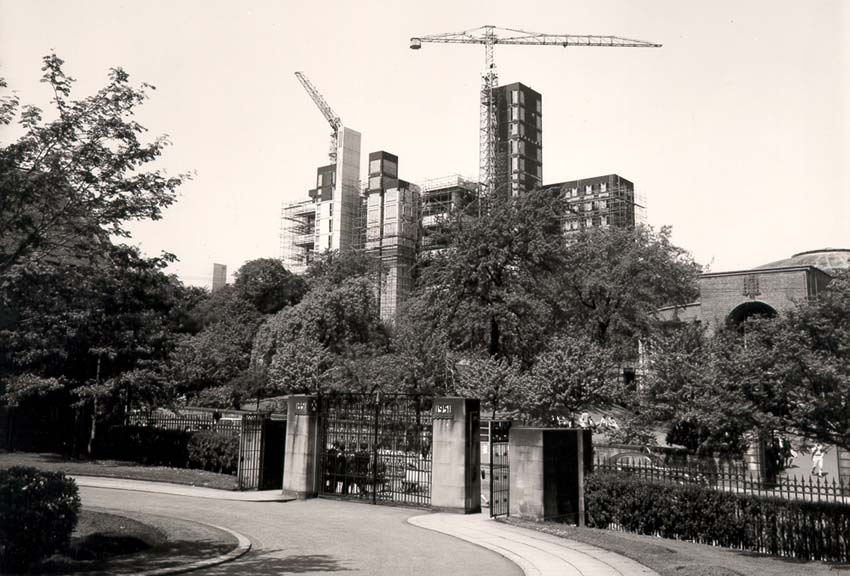
Photo A49/83/1: Library under construction, with Memorial
Gates in foreground, 13 June 1967
|
|
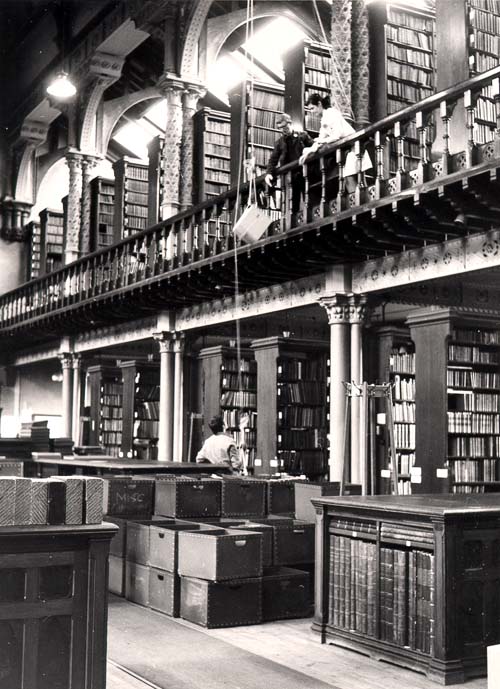
Photo A49/84: move of books from old library,
books being lowered from the Gallery in the Upper Hall, c. August
1968
(copyright Glasgow Herald: ref E7351C)
|
| The old library was situated in the North front of the
Arts Quadrangle in the Gilbert Scott building. It had well
out grown its purpose. At
the time of the University's move to Gilmorehill from the city centre in
1870, it was described as being "well lighted and commodious, and
contains provision probably sufficient at the present rate of increase
for the next fifty years". It finally closed in July 1968, after nearly
one hundred years of service.
|
|
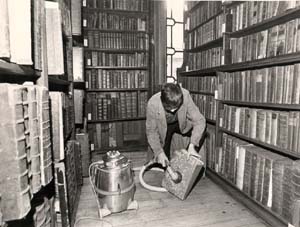
Photo A49/87: books being cleaned before the move,
c. August 1968 (copyright Glasgow Herald: ref E7351)
(click on this image to see a larger version)
|
| The move of books took three months and it was a case
of "all hands on deck". A memorandum to all library staff issued in
September 1967 had warned against booking holidays in advance for the
summer vacation of 1968 as it was not then possible to guarantee time
off for particular dates. Markers were placed in books on every shelf in
the old library giving the exact identification of location in the new
library. Books were then moved into boxes shelf by shelf before being
wheeled into waiting vans for transportation and unpacking at the other
end. This relatively simple plan of campaign was "enormously
complicated" by difficulties on both sides: in the old
library, passages were narrow and tortuous, hampering movement of
trolleys, and boxes had to lowered from upper floors by pulleys or
chutes; in the
new building, workmen were everywhere, some floors were still up, and
the lifts only worked intermittently. |
|
|
30 students were drafted in to help with the "heaving and "trucking".
However, in another memorandum to his long suffering staff, MacKenna
hoped that "you will all join in the unavoidably hard, dirty and lengthy
jobs which we must all do before we can say goodbye to our present
premises ... the technical term for this is Mucking In". |
|
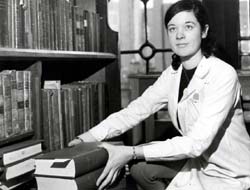
Photo A49/91: staff moving books c. August 1968
(copyright Glasgow Herald: ref E7351K)
(click on this image to see a larger version)
|
| On the plus side, a free supply of tea, coffee and
biscuits was provided at break times - although the ulterior motive for
this was to prevent unnecessary time wasted "in expeditions to the
College Club and Refectory" in search of refreshment. |
|
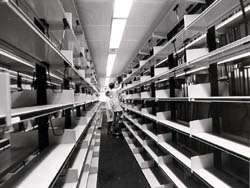
Photo A49/88: staff unpacking books in new library,
c. August 1968 (copyright Glasgow Herald: ref E7350)
(click on this image to see a larger version)
|
|
Despite all the setbacks, the move was completed within the time
envisaged and more than 600,000 volumes were successfully transferred.
The new building opened to readers at 9.30 am on Monday, 30 September
1968 on time as planned. Staff
started work half an hour earlier to attend a briefing, but there was no
opening ceremony of any sort.
|
|
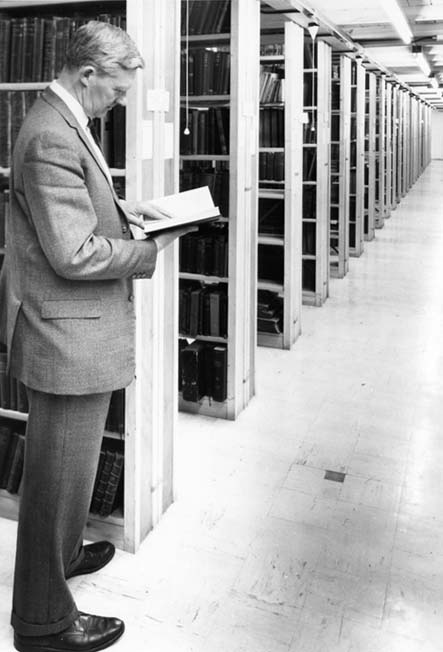
Photo A49/100: University Librarian, R. O. MacKenna in the
sub-basement of the new Library, 7 August 1968 |
|
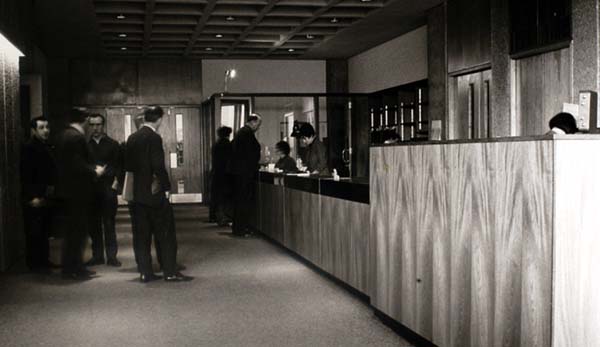
Library issue desk (Library records: uncatalogued) |
In its original configuration, the building provided some 925
reading places and held 750,000 books. It had to serve 8000 students, staff,
graduates and visiting scholars. In the long term, with the projected
extension, the building would have held 1.5 million books and had seating
for 2000 readers. The issue desk, central catalogue and reference service
were located on
the ground floor, along with the Hunterian Library and exhibition area. The basement and sub basement contained newspaper and
microform stores, cloakrooms, a bindery, machine room/plant areas and photographic
department, as well as a closed stack and Special Collections areas. |
| The eight upper floors each housed a subject or group of allied
subjects, with a dedicated enquiry desk staffed by a subject specialist
team. In his brief to the architects of 1962, MacKenna had written "The
Library is to be thought of not as a storehouse for books but as a workshop
for readers using books. The emphasis must be on bringing books and readers
together, with the Library staff acting as intermediaries in the process and
this should make itself evident as the keynote of the design from the moment
one sets foot in the building". The move to a new building had provided the
opportunity to reconfigure the
library services as a whole and reorganise staff into dedicated subject
areas. MacKenna was one of the earliest advocates of the importance of
developing reader services, and was keen to make closer contacts between the
library and University departments. Many of his staff entered the new
library in new roles.
|
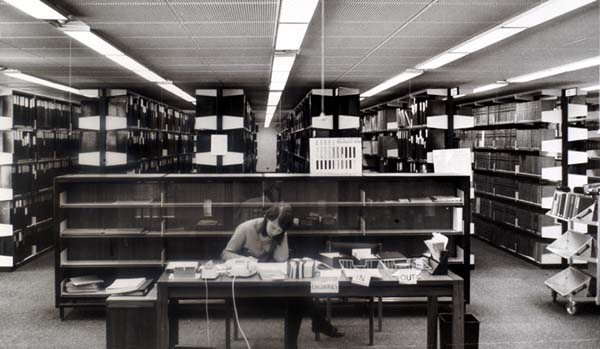
Subject floor enquiry desk (Library records: uncatalogued)
|
|
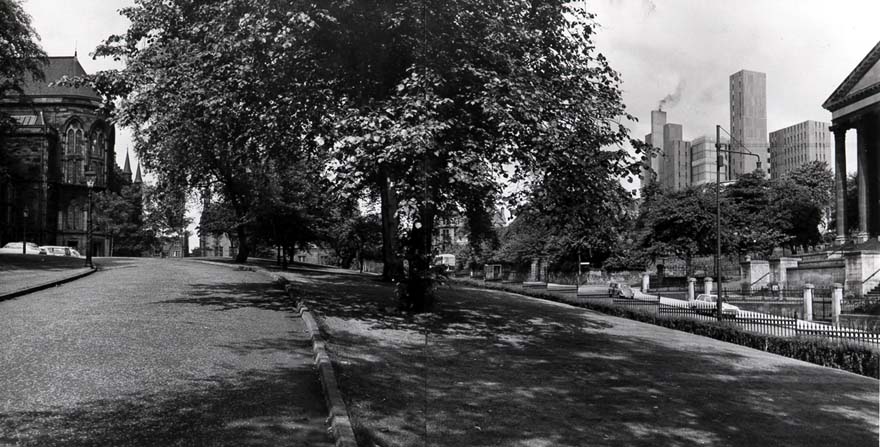
Photo A49/97: the new Library, from the South East, c. 30 June 1969 |
|
Huge tower blocks of concrete and glass have now gone out of fashion, but
at the time the architectural press were enthusiastic about this modern
addition to the University. The Architectural Review stated that this
dramatic structure was "important to Glasgow as well
as to the university because of its dominating site ... it adds a new major
climax to the city skyline". The Architect's Journal was more muted
in its praise. It agreed that this was "unquestionably a building of great
significance" which "contributes powerfully to the architecture of the
city".
| However, it concluded that the limited budget had been directed to
its external appearance, compromising on its practicality as a working
library: "major conflicts exist within it; one must therefore question
the balance achieved between image and function, in relation to its
fulfilment of the written brief". In particular, the reviewer realized
with ominous foresight that - if the projected expansion did not occur -
in terms of space it was "already less than adequate for the present
needs of a university". He also foresaw problems with overheating thanks
to the fully glazed windows; although provision had been made for air
conditioning, refrigeration and humidity control had been omitted on the
floors for economic reasons, and thus there was no way of controlling
temperature in the summer: "Why complicate the problem of maintaining a
constant quality of environment by providing extensive double height
windows of obscured glass through which readers cannot even see?".
Furthermore, the issue of easy movement around a high rise building with
only two lifts was questioned. Many of these problems would have been
alleviated had the initial plans for phases II and III of the
development been implemented. Unfortunately, owing to cuts in public
spending and inevitable economic constraints, this was not to be. The
connecting Hunterian Art Gallery was not completed until 1978, while the
Library extension - originally planned as a mirror image of Phase I of
the building - was added in two stages in a much modified design as late
as 1982-3 and 1986. |
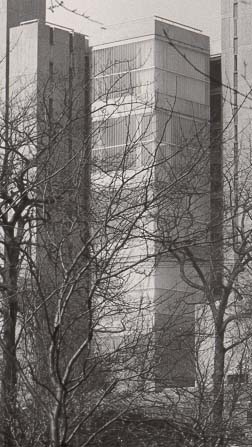
Photo A49/104/1: detail of main floors of
new library, showing original double height
opaque glass windows, about March 1971 |
|
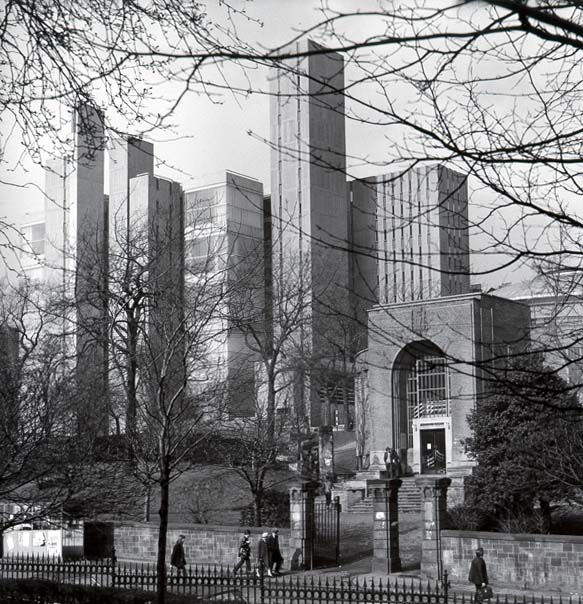
Photo A49/104/1: new library from the South East
in the gardens in front of the Gilbert Scott
building, with the Round Reading Room in the foreground, about March
1971
|
Although lauded as
MacKenna's greatest achievement, in reality the new building - at least
initially - proved to be a frustration and disappointment. MacKenna had warned staff to be patient with teething problems,
predicting that the building and its new mode of service would take about a year to "run in".
However, by the end of the first year, parts of the building were still
unfinished and several of its planned services were not yet in operation
or available. The Library Committee minutes sadly note that "the new building has not been as comfortable as might
have been hoped". There were delays in the delivery of furniture; lack of directional signs
resulted in a plethora of not so temporary hand written notices
everywhere; there was not enough cloak room space;
there were leaks; and there was constant trouble with the lifts which
were frequently out of action. Finally, the windows proved to be
vulnerable to the frequent gale force winds that assailed the top of the
hill; some reader areas had to be closed off for repairs, and eventually
they were replaced. Some of these problems are horribly familiar
even today! But, for the first time, shelf access to all readers was possible
and membership of the library grew. It became a place where students
could study and work, while the new
pattern of staff organization was successful in providing a
more direct service to readers. It took about three years for the new system to bed in, but by the by end of the 1971-72 session, MacKenna could
as last claim of his new library that "a coherent pattern had evolved".
|
|
Other items of interest:
Photographs relating to the library (a
sequence documenting the move, as well as others relating to both the
old and new library, library staff etc):
Photo A49
Records of Glasgow University Library: this is a restricted
collection and is currently being catalogued (MS Lib): enquire at
Special Collections for further advice.
See also the book of the months on
University of Glasgow
Old and New (July 2008) and Glasgow in
Panorama (June 2004) which
documents the West End landscape of 1907 before the University's further
redevelopment of the area.
The following have
been useful in creating this article:
A. L. Brown and Michael Moss The University of
Glasgow: 1451-1996 Edinburgh: Edinburgh University Press, 1996
James Ireland Lib
Education S271 1996-B
'Building study: Library at Glasgow
University' The Architect's Journal (Information Library section)16
April 1969 Number 16 Vol. 149 pp. 1043-1058
Level 11
Fine Arts PERS
AR 100
Committee on Higher Education Higher education: report of the
Committee appointed by the Prime Minister under the chairmanship of Lord
Robbins, 1961-63 : presented to Parliament by the Prime Minister ... London:
H.M.S.O., 1963 Level 4 Main Lib Education P11
1963-C2
'Criticism: the new climax to the Glasgow
skyline' and 'Library, Glasgow University' The Architectural Review
April 1969 Vol. 145 No. 966 pp. 250-251 and pp. 252-258
Level 11
Fine Arts Pers
AR150
W.P. Dickson The
Glasgow University Library: notes on its history, arrangements, and aims
Glasgow: James MacLehose & Sons, 1888
Level 11 Main Lib
Bibliog A39:32 1888-D and Sp Coll Mu21-a.34
'Glasgow University New
Library' The Times December 28, 1962
Times article available online
Molly McIlwraith and Elizabeth Rodger
'Robert Ogilvie MacKenna: an appreciation' Library Review Vol 40 No2/3
1991 pp. 5-7 Sp Coll RQ 2034
Records of Glasgow University Library:
internal Library planning documentation (including 4 page typescript
'Glasgow University Library' with building outline and specifications; 5 page
typescript brief 'University of Glasgow: outline programme for new library
building (Revised: July 1962)'; Reports of the Library Committee;
Sessions 1961-62 to 1971-72. [Sp Coll: uncatalogued]
Cordula Zeidler and Patrick Duerden 'Gillespie Kidd and Coia in context: post
war architecture in and around Glasgow' The Twentieth Century
Society (conference paper?) 22-24 April 2005 [Sp Coll:
uncatalogued library records]
Return to main Special Collections
Exhibition Page
Go to previous
Books of the Month
Julie Gardham September 2008 |
|